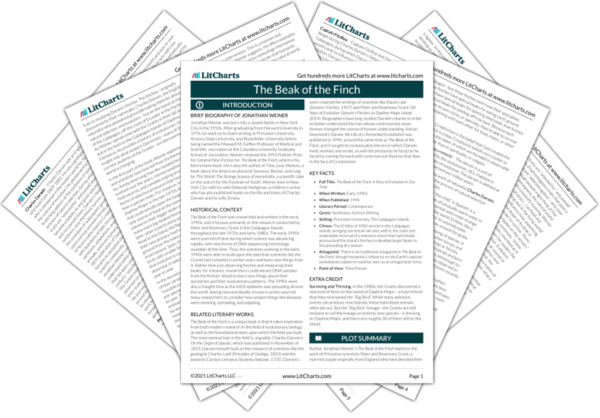Adaptive Radiation Quotes in The Beak of the Finch
Selection will act in this way on all neighboring varieties, […] and the effect will be continually to move varieties apart and repel them. Even if they never actually jostle and joust, […] natural selection will gradually magnify their differences.
At last the two varieties will move so far apart that competition will slack off. It will slack off when the two varieties have evolved in new directions: when they have diverged. Natural selection will have led in effect to another adaptation—the mutual adaptation of two neighbors to the pressures of each other existence. And the result of this sort of adaptation would be forks in the road, partings of the ways, new branches on the tree of life: the pattern now known as an adaptive radiation.

Unlock explanations and citation info for this and every other The Beak of the Finch quote.
Plus so much more...
Get LitCharts A+Thus the Grants suspect that the finches here are perpetually being forced slightly apart and drifting back together again. A drought favors groups of one beak length or another. It splits the population and forces it onto two slightly separate adaptive peaks. But because the two peaks are so close together, and there is no room for them to widen farther apart, random mating brings the birds back together again.
These two forces of fission and fusion fight forever among the birds. The force of fission works toward the creation of a whole new line, a lineage that could shoot off into a new species. The force of fusion brings them back together.
These two oscillations are driven by the same events. They are both governed by the same changes in the adaptive landscape. In an adaptive landscape that is wrinkling and rolling as fast as Daphne, a landscape in which the peaks are in geological upheaval, it can pay to be born different, to carry a beak 3, 4, or 5 millimeters away from the tried and true. Since the super-Niño, some of the old peaks have turned into valleys, and some of the old valleys are peaks. Now a hybrid has a chance of coming down on the summit of a new peak. It can luck onto a piece of the new shifting ground.












